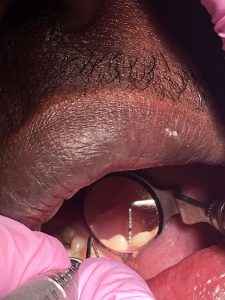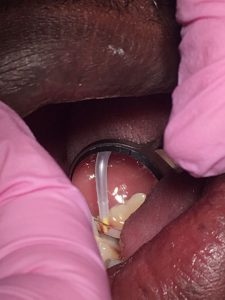Case Study 1: Medically compromised patient
A 77 y.o white male came in for his 6 month recare in the clinic. Due to his medical history having been more than 3 years old, I instructed him to fill out a new one; and only then did the patient reveal to me that he had a mitral valve replacement one, two, and three years earlier. This patient was previously treated in the clinic without knowing about all the surgeries due to the “cardiovascular disease” box not being checked off. Based on the patient’s’ medical history and that I was unable to confer with the M.D, the patient was dismissed with a medical clearance request form and no treatment was rendered.
V1: L/I 77 y.o white male, history of high BP and three mitral valve replacements due to two mitral valve replacement failures. Rx for Azithromycin 500mg was prescribed and patient took them that morning. Clearance letter from physician was obtained from the patient and scanned into his chart. Patient takes 85 mg aspirin, lisinopril, and 100 mg metoprolol daily for his cardiac condition and high BP. EO/IO exam was negative. Dental charting: Suspicious caries on tooth #3-DOL, tooth #4 is missing, and patient has implants on tooth #’s 14 and 15. Patient has generalized attrition, abrasion on tooth #’s 11, 13, 19, and 30, and generalized acid erosion consisting of pitting/cupping of the incisal edge and occlusal surfaces. Patient reported drinking fresh lemonade often and stated he had no sensitivity from it. Class of occlusion II, overjet 3 mm, overbite 2%. Perio: Gingiva was pink, blunted papilla by anterior teeth, stippled, and non-resilient. Generalized 1-3mm PD with localized 4-5mm PD by post. teeth. Minimal BUP. Minimal calculus present. No staining. The treatment plan consisted of two visits.
V1: Completion of all assessments, OHI- plaque score 1.0=Fair, taught flossing technique and recommended to flush out mouth with water after drinking lemonade to prevent further acid erosion. Hand scaled and ultrasonic URQ. Referral was given for caries on tooth #3-DOL and for a replacement for tooth #4.
V2: Re-evaluated previously scaled areas, checking for any residual calculus present and tissue response. Patients tissue was still pink, had blunted papilla by anterior teeth, stippled and was non-resilient. OHI- Patient reported being compliant to home care instruction given by last visit. Plaque score 1.0=Fair. Taught modified bass TB method, handscaled and ultrasonic UL, LR, LL Quadrants. Polished with fine paste. Patient refused fluoride treatment. Patient was placed on a 6 month recare schedule.
Case study 2: Periodontally involved patient
Initial visit/H/III- 32 y.o African American, male, healthy with normal BP, non-smoker, no systemic conditions, no medications. EO/IO was negative. Dental charting: Patient presented with tooth #9 missing and suspicious carious lesions on tooth #’s 14- MD, 15-MO, 16-OD, 17-O, 19-OD, 30-D, and 32-O. Patient had a tooth fracture on # 26-O Patient had generalized attrition, bilateral class I occlusion, edge to edge bite, and crowding by lower anteriors. Perio: Gingiva was pink, fit interdental spaces, had rolled margins by posterior teeth, stippled, and was non-resilient. Pateint had 1-3mm PD by anterior teeth and 4-7mm PD by post. teeth. Patient had minimal staining by max. incisors, lingually. Patient requires FMS radiographs. Heavy subgingival calculus present. The treatment plan consisted of 5 visits.
V1: Completion of all assessments. OHI- plaque score 2.0=Fair, taught modified bass TB method. Recommended rinsing with Listerine Antiseptic with 10ml for 30 seconds, daily. Handscaled and ultrasonic tooth #’s 25-28.
V2: Re-evaluated previously scaled areas, checking for any residual calculus present and tissue response. Gingiva was pink, fit interdental spaces, had rolled margins by posterior teeth, stippled, and was non-resilient. OHI- Plaque score 1.8=Fair. Patient reported being compliant to home care instructions taught by previous visit. Taught proper flossing technique; recommended using a reach flosser. Exposed FMS radiographs; radiographs revealed bone loss and confirmed previous suspicious caries. Handscaled and ultrasonic tooth #’s 28-32. Due to sensitivity, injected 1/3 carpule of 2% lidocaine 1:100,000 with epi. Patient tolerated well to the anesthesia. A referral was given for for carious lesions on tooth #’s 14- MD, 15-MO, 16-OD, 17-O, 19-OD, 30-D, and 32-O.
V3: Re-evaluated previously scaled areas, checking for any residual calculus present and tissue response. Gingiva of previously scaled teeth were pink, fit interdental spaces, stippled, and were resilient. OHI- Plaque score 1.8=Fair. Handscaled and ultrasonic LL and UR Quadrants. Due to sensitivity, injected 1 carpule of 2% lidocaine 1:100,000 with epi.
V4: Re-evaluated previously scaled areas, checking for any residual calculus present and tissue response. Gingiva of previously scaled teeth were pink, fit interdental spaces, stippled, and were resilient. OHI- Plaque score 1.5=Fair. Handscaled and ultrasonic ULQ. Due to sensitivity, injected 2% Lidocaine 1:100,000 with epi. Placed 1 carpule of Arestin in 30-DL[7mm] , 30-ML[5mm] , 31-DB[6mm] , 31-MB[5mm], and 31-DL[7mm]. polished with fine paste except areas treated with Arestin. Verbal post instructions as well as written post instructions for Arestin placement was sent home with the patient.
The patient returned 1 month later for re-evaluation of Arestin placement. All the sites except 31-DL had pocket reductions of about 1-3mm. The patient’s gingiva appeared much healthier and the inflammation was visibly reduced as well. Even areas where arestin was not placed, the updated PD were generalized 1-4mm. The patient was very pleased with his results. I encouraged the patient that continuing his home care and regular dental visits is key in maintaining his oral health condition. The patient was placed on a 3 month recare schedule.




